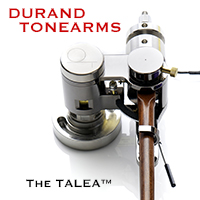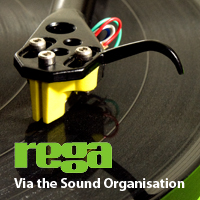Naim SuperLine
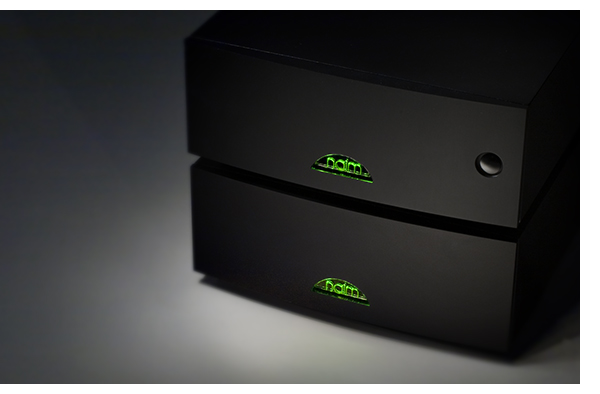
(Ed. note: This review originally ran in issue #21 of TONEAudio. While some of my reference components have changed since this review, the SuperLine/SuperCap combination is still part of our reference fleet. Our enthusiasm for this phonostage is as high as it was almost three years ago.)
I agree with Naim that a hefty power supply goes a long way to achieve big, natural dynamic sound.
My other reference phono preamplifier, the Aesthetix IO, also has two external power supplies, and in my book, is the pinnacle of analog reproduction, but it’s full of tubes.
These days, I just can’t get behind 32 vacuum tubes to play a record. The 12AX7’s of only moderate quality can fetch $50 each and the exceptional ones can cost three times that. As SpongeBob likes to say, “That’s crazy talk.” Enter the Superline solid-state phono preamplifier: all of the analog goodness, none of the tube hassle.
Don’t put me in the valve-hater category. I still enjoy them in small doses, but I spend a lot of time with my system fired up, and there’s nothing more frustrating than getting a tube preamplifier sorted to perfection only to lose the magic when it’s time to retube. This happened to me recently, so I am on a quest to eliminate, or at least minimize, the glowing bottles in my system.
When asking Naim why they produce a premier phonostage when they don’t even make a turntable, the answer was simple. As a company that goes way back with analog, they still wanted to produce what they feel is the best phonostage they are capable of making. It’s their way of giving something back to the analog community.
Like a Butterfinger, the surprise is inside
In understated British fashion, the Superline looks like a little black box, slightly narrower than a standard Naim component and lacking even a power switch on the front panel, just a backlit green Naim logo. When you pick it up and realize it weighs more than a Nait 5i integrated amplifier, it sinks in that this is a serious phono stage.
The circuit board is suspended, floating inside the case, much like Naim’s approach to the CD555 CD player. The actual preamplifier is a single-ended, Class-A design, with no op amps in sight. The wiring is executed with surgical precision and features 25 internal regulators while borrowing thermal isolation concepts from Naim’s flagship NAP power amplifier.
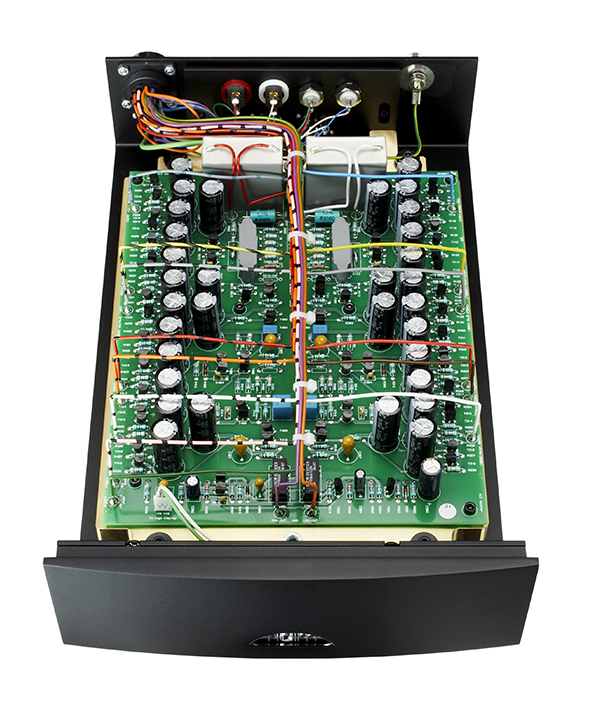 Powerful Options
Powerful Options
Some criticize Naim for taking the separate-power-supply approach, but I applaud it. I hate getting rid of gear to which I get attached, so I prefer components with an upgrade path. The Superline itself retails for $2,950 without a power supply, but it offers a number of power options. This allows you to purchase a top-shelf phono stage that you can upgrade as your system improves by merely changing the power supply.
If you own one of the SuperNait integrated amplifiers, or a Naim preamplifier, you can power the Superline with that. I started my journey plugging the Superline into the SuperNait and was quite impressed. If you will use the Superline in a non-Naim system (or just want more power) you can mate it with their entry-level FlatCap 2x ($1,100), a HiCap 2 ($1,900) or the SuperCap2. ($5,950) If you are on a tight budget, you can usually find an original FlatCap used for about $500 from a Naim owner moving along the upgrade path. Still with me?
You also have the option of purchasing the Superline in a standard (58db) or high-gain (64db) model. I had the high-gain version here, which worked fine with my Dynavector 17D3 with its .23mv output and it had no problem handling the 2.5mv output of the Sumiko Blackbird without overload. So it should work well with whatever cartridge you have. Keep in mind, though, that this phono preamplifier is not intended for MM cartridges.
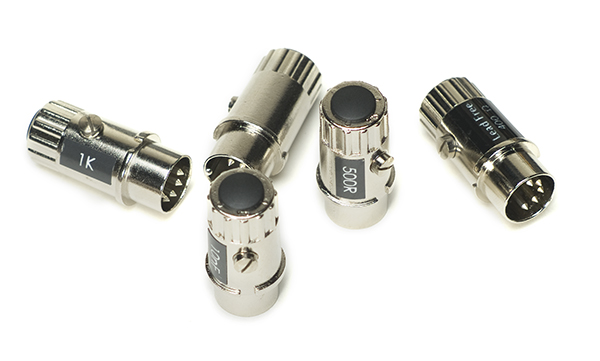 Lightning fast setup
Lightning fast setup
When first setting up, be sure to remove the two transit screws that keep the floating circuit board secure (the manual warns you not to use the Superline with the screws still in place) and I suggest putting them in a Ziploc bag and taping them to the inside of the shipping carton, just in case you ever need them. Keep the Superline level and over a table while you are removing the screws and then carry it gently to where it will be used, as it is now floating free.
Once the Superline is connected to your power supply, the next step is to set loading and input capacitance. Naim supplies four resistive plugs and three capacitive ones, giving you loading options of 100 ohms, 500 ohms, 1,000 ohms and 10,000 ohms. Chris Koster from Naim USA suggests a 440-ohm plug with the Lyra Olympos cartridge, and he sent along a custom loading plug. Should you have a cartridge that requires different loading, your Naim dealer can have custom sets made for you at $60 each. The plugs are tightly matched for value and channel balance, so I’d advise against doing this yourself. I used the minimal capacitance loading with all of the cartridges tested.
I still had my ASR Basis Exclusive when the Superline first arrived, and the first thing that struck me about the Naim was that it is every bit as quiet as the battery-powered phono stage that was off the grid entirely! So chalk up an immediate victory for the engineers at Naim. The ASR depends on very high-quality op amps, however, and is not nearly as grain-free as the Superline, even while plugged into the SuperNait.
Four cartridges were used for the primary evaluation of the Naim combo – the Dynavector XV-1s, the Lyra Skala, the MoFi 3.5C and the Lyra Olympos. Thanks to the ease of changing the loading on this preamplifier, it was easy to optimize for each cartridge. Koster was kind enough to send an extra 470-ohm loading plug, which he felt would be optimum for the Olympos. The Skala found happiness at 220 ohms while the other two preferred 100 ohms.
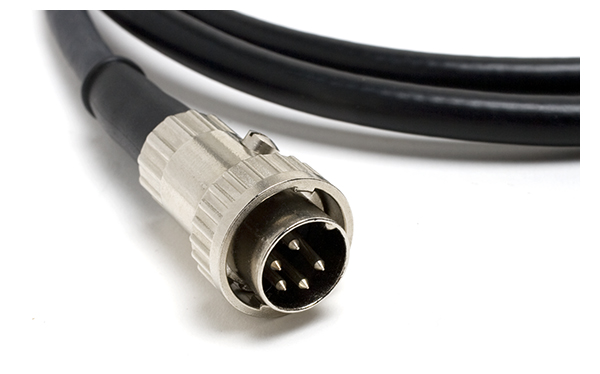 Snaic or Burndy?
Snaic or Burndy?
I did not get a chance to audition the Superline with the FlatCap power supply; the rest of the review period was spent with the HiCap2 and the Supercap. If you are not a current Naim user, you will need to familiarize yourself with their various cable and connection options.
Plugging into a SuperNait, requires a Snaic, as does the FlatCap or HighCap2. This is a five-pin cable that brings current to the Superline and high level audio output back to the power supply. You plug your tonearm cable right into the Superline and you take another cable (Din if you have an all Naim system or a Din-to-RCA cable in a non-Naim system) out to your linestage; this works the same with all three power supplies. The SuperCap2 will require the higher-capacity Burndy cable, which goes where that big plug is on the back of the Superline.
Analog bliss, a stage at a time
Those who have heard the Superline with one of the smaller supplies may wonder what all the fuss is about. As an addition to your Naim preamplifier or SuperNait, the Superline makes a good showing and is well worth the asking price. When the HighCap2 is added to the equation, you start thinking something pretty special is lurking inside that little black box. And by adding the SuperCap2, you are taken somewhere very special indeed.
It is always a challenge to describe a component this good because all the great audiophile clichés have already been taken. Cutting to the chase, I’ve never heard a phono preamplifier reveal more information from the black grooves than the Superline/SuperCap2. What puts the Superline/SuperCap2 solidly on the top of the mountain is the presentation; those seeking tonal neutrality and boundless dynamic range will be in heaven. This combination knocks down the walls of your listening room, expanding the presentation in all three dimensions.
I like that big, big sound, and the Superline/SuperCap2 gets it right. It doesn’t make everything sound big, but it has a very precise ability to capture dynamic contrasts and spatial cues, doing a good job at convincing your brain that what you are hearing is happening right in front of you.
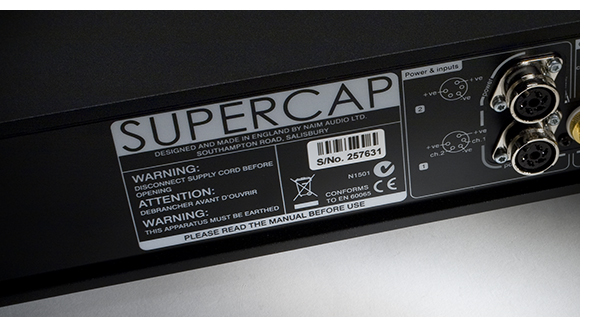 The Superline had plenty of hours on its clock from using it for the SuperNait review, and I thought I was very familiar with the sound. But after the addition of the SuperCap2, I was on another planet. I haven’t been this impressed with a phono preamplifier since the famous Vendetta Research of the ’80’s, which was the last time I had a major paradigm shift in analog listening. In my system, the Superline/SuperCap2 opened the window to the music wider than it has ever been.
The Superline had plenty of hours on its clock from using it for the SuperNait review, and I thought I was very familiar with the sound. But after the addition of the SuperCap2, I was on another planet. I haven’t been this impressed with a phono preamplifier since the famous Vendetta Research of the ’80’s, which was the last time I had a major paradigm shift in analog listening. In my system, the Superline/SuperCap2 opened the window to the music wider than it has ever been.
The Superline/SuperCap 2 hits you first with its weight and power, but it keeps you riveted to your chair with subtlety and nuance. Naim enthusiasts always like to talk about the immediacy of their gear, and the Superline/SuperCap 2 has that quality in spades. Everything else I’ve heard in comparison sounds moderately hazy. As expected, the perfect tonality of this preamplifier is intact, even with the basic configuration, but as you increase the power supply you get more dynamics, less noise and a more-sorted view of the music.
The Naim Superline with SuperCap2 power supply is the closest I’ve heard to analog perfection. It neither adds nor subtracts from what’s in the groove and faithfully offers what I’m looking for in any component. It offers a staggering level of resolution without being harsh or forward. while offering tremendous musicality without being overly romantic or rounding off the edges of musical transients in an effort to sound polite.
Not an audiophile component
Phenomenal recordings will send you into bliss, yet even average recordings will yield sonic rewards that with surprise you. While the Superline/SuperCap2 does not romanticize, should you want that sound, you can always mate it with a romantic-sounding cartridge. I could have easily lived with either the lush presentation of the Lyra Olympos or the slightly more neutral, yet dynamic, presentation of the Dynavector XV-1s. Every one of the cartridges in my stable sounded fantastic!
One of the biggest complaints I hear from people with mega systems is that they only sound good while playing a handful of “audiophile-approved” records. This couldn’t be further from the truth with the Superline/SuperCap2 combination. Sure, the best pressings gave their all, but I have a substantial collection of just-average records. So I went on a power pop binge and listened to a lot of my favorite but fairly lousy-sounding records one night, and I was astonished at how much was actually lurking in those grooves.
On Cheap Trick’s self titled album, when Tom Petersson’s bass line kicks in on “Mandocello,” I felt like that Maxell guy in my chair. Substituting a popular $1,000 phono preamplifier and playing that cut again (with the $10,000 Lyra Olympos), it became flat and uninvolving, completely lacking any depth. I moved on to a few of my favorite Elvis Costello records, Squeeze, XTC and The Sinceros before calling it a night with “Christmas with the Chipmunks.” Damn, even that sounded good.
Should you install a Superline/SuperCap2 into your system, I guarantee the phono stage will no longer be the weak link in your system. It will not bring back the parts of your marginal recordings that suffer from compression, but it will extract every bit of music your turntable, tonearm and cartridge are capable of delivering.
With the average records sounding fantastic, the fantastic records sound dreamy. When listening to Ella Fitzgerald on the “Ella Sings the Cole Porter Catalog” box set, she was in the room, six feet in front of my listening chair. In a completely different vein, the LP version of The Beastie Boys’ The Mix Up was a true psychedelic event. Though a little crunchy on the extreme high end, this record is a giant, surreal soundscape, with bongos, synthesizers and crunchy guitars floating all over the place, with big, thumping bass lines running in and out of the music. Again, on a lesser analog setup, it just sounded flat and CD-like, but through the Superline/SuperCap2, I was amazed at how much information lurked on this disc.
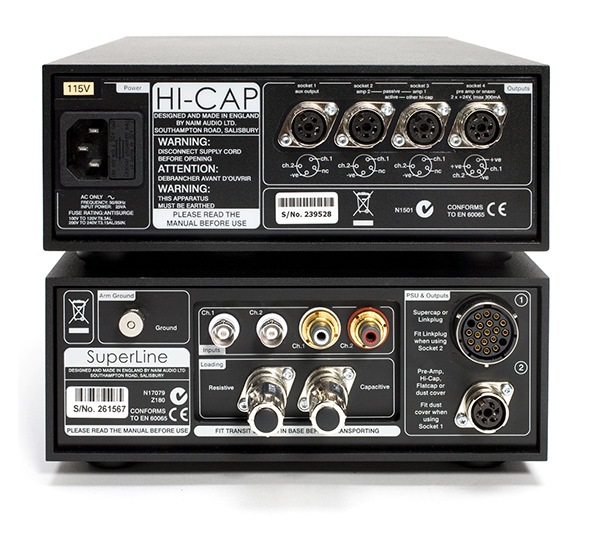 Super squared
Super squared
I’ve owned a Naim CD555 for nearly two years with no diminishment in enjoyment whatsoever. It’s looking as if another pair of Naim boxes are in my immediate future, and I’m anticipating the same result with the Superline and SuperCap2.
My biggest expectation for a five-figure component is that it should take me somewhere that I’ve never been. The world of the Superline/SuperCap2 is one of those places, and I always have a hard time leaving it and coming back to reality. When I was proofing this article, Microsoft Word wanted to keep changing Superline to Superfine. Maybe the ghost in the machine had a point.
Peripherals
Turntables Continuum Criterion w/Copperhead Tonearm, TK Acustic Raven Two w/SME 309 and SME iV.Vi tonearms, Spiral Groove SG-2 w/TriPlanar vii
Cartridges Dynavector 17D3 and XV-1s, Lyra Skala and Olympos, MoFi 3.5C, Sumiko Blackbird
Tonearm Cables Furutech
Preamplifiers Conrad-Johnson ACT2/series 2, Nagra PL-L, BAT VK-32SE
Power Amplifiers BAT VK-55SE, Conrad-Johnson Premier 350, Nagra PSA, Naim SuperNait (integrated)
Speakers Harbeth Monitor 40.1, MartinLogan CLX w/Descent i subwoofers, Verity Audio Sarastro II
Power Running Springs Dmitri and Jaco Power Line Conditioners, RSA Mongoose Power cords, Shunyata Anaconda Vx power cords
Interconnects Shunyata Antares, Cardas Golden Reference
Speaker Cables Shunyata Orion
Accessories Furutech DeMag, Shunyata Dark Field Elevators




